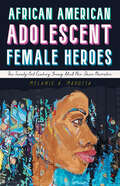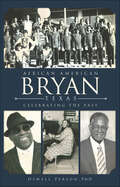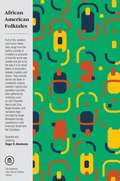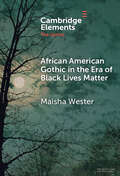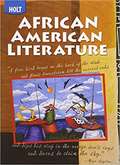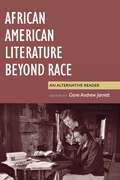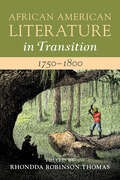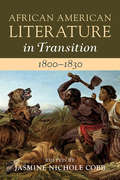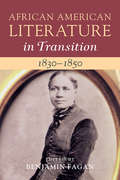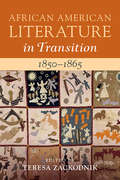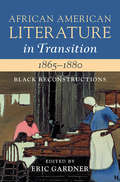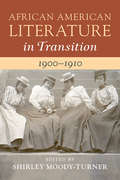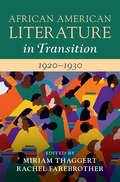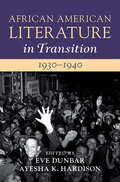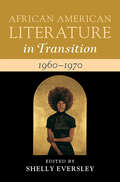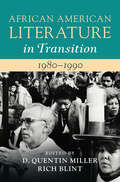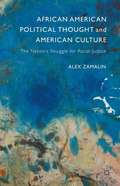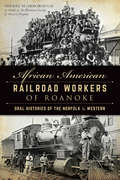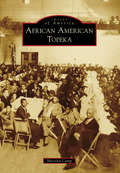- Table View
- List View
African American Adolescent Female Heroes: The Twenty-First-Century Young Adult Neo-Slave Narrative (Children's Literature Association Series)
by Melanie A. MarottaIn the wake of the second wave of the Black Lives Matter movement, inequalities and disparities were brought to light across the publishing industry. The need for more diverse, representative young adult literature gained new traction, resulting in an influx of young adult speculative fiction featuring African American young women. While the #BlackGirlMagic movement inspired a wave of positive African American female heroes in young adult fiction, it is still important to acknowledge the history and legacy of enslavement in America and their impact on literature. Many of the depictions of young Black women in contemporary speculative fiction still rely on stereotypical representations rooted in American enslavement.African American Adolescent Female Heroes: The Twenty-First-Century Young Adult Neo-Slave Narrative investigates the application of the neo-slave narrative structure to the twenty-first-century young adult text. Author Melanie A. Marotta examines texts featuring a female, adolescent protagonist of color, including Orleans, Tankborn, The Book of Phoenix, Binti, and The Black God’s Drums, as well as series like the Devil’s Wake series, Octavia E. Butler’s Parable series, and the Dread Nation series. Taken together, these chapters seek to analyze whether the roles for adolescent female characters of color are changing or whether they remain re-creations of traditional slave narrative roles. Further, the chapters explore if trauma, healing, and activism are enacted in this genre.
African American Bryan, Texas: Celebrating the Past (American Heritage)
by Oswell Person PhDBryan was incorporated in 1872, but it would take more than ten years before its African American population was offered schooling. Nothing would come easy for them, but they persevered through hard work, ingenuity and family support. The success of today's generation is a direct result of determined, hardworking pioneers like Dr. Samuel J. Sealey Sr., Bryan's "baby doctor" in the 1930s and '40s, and Dr. William A. Hammond Sr., who opened Bryan's first black hospital and employed many blacks through his business ventures. Learn about the inspiration and guidance provided by the likes of Oliver Wayne Sadberry, an outstanding community leader and principal of Fairview and Washington Elementary. Dr. Oswell Person shares the story of this community's achievements, successes and contributions in the face of incredible odds.
African American Folktales: Stories from Black Traditions in the New World (The Pantheon Fairy Tale and Folklore Library)
by Roger AbrahamsFrom the canefileds of the ante-bellum South, the villages of the Caribbean islands, and the streets of contemporary inner cities, here are more than one hundred tales from an "incredibly rich and affirmative storytelling tradition" (Choice).Full of life, wisdom, and humor, these tales range from the earthy comedy of tricksters to stories explaining how the world was created and got to be the way it is, to moral fables that tell of encounters between masters and slaves. They includes stories set down in travelers' reports and plantation journals from the early nineteenth century, tales gathered by collectors such as Joel Chandler Harris and Zora Neale Hurston, and narratives tape-recorded by Roger Abrahams himself during extensive expeditions throughout the American South and the Caribbean.From the Trade Paperback edition.
African American Gothic
by Maisha L. WesterThis new critique of contemporary African-American fiction explores its intersections with and critiques of the Gothic genre. Wester reveals the myriad ways writers manipulate the genre to critique the gothic's traditional racial ideologies and the mechanisms that were appropriated and re-articulated as a useful vehicle for the enunciation of the peculiar terrors and complexities of black existence in America. Re-reading major African American literary texts such as Narrative of the Life of Frederick Douglass, Of One Blood, Cane, Invisible Man, and Corregidora African American Gothic investigates texts from each major era in African American Culture to show how the gothic has consistently circulated throughout the African American literary canon.
African American Gothic in the Era of Black Lives Matter (Elements in the Gothic)
by Maisha WesterThis Element explores twenty-first century Black Gothic literature and film as it responds to American anti-Blackness and as they illustrate a mode of Black Gothic fiction termed Black Lives Matter (BLM) Gothic. The various texts express frustration, rage, and sorrow over the failures of previous civil rights fights. Intended as an introduction to a complex mode, this Element explores the three central themes in BLM Gothic texts and defines the mode's pattern of tropes. The first section reviews the depictions of American anti-Blackness, and defines the mode's pattern of tropes reveal the necropolitical mechanisms at play in US systemic racism. The second section explores the ways the fictions 'make whiteness strange' in order to destabilize white normativity and shatter the power arising from such claims. The final section examines the costs of waging war against racial oppression and the power of embracing 'monstrosity'.
African American Literary Theory
by Winston Napier"African American Literary Theory is an extraordinary gift to literary studies. It is necessary, authoritative and thorough. The timing of this book is superb!" -Karla F.C. Holloway, Duke University"The influence of African American literature can be attributed, in no small part, to the literary theorists gathered in this collection. This is a superb anthology that represents a diversity of voices and points of view, and a much needed historical retrospective of how African American literary theory has developed." -Marlon B. Ross, University of Michigan"A volume of great conceptual significance and originality in its focus on the development of African American literary theory." -Farah Jasmine Griffin, University of PennsylvaniaAfrican American Literary Theory: A Reader is the first volume to document the central texts and arguments in African American literary theory from the 1920s through the present. As the volume progresses chronologically from the rise of a black aesthetic criticism, through the Blacks Arts Movement, feminism, structuralism and poststructuralism, and the rise of queer theory, it focuses on the key arguments, themes, and debates in each period.By constantly bringing attention to the larger political and cultural issues at stake in the interpretation of literary texts, the critics gathered here have contributed mightily to the prominence and popularity of African American literature in this country and abroad. African American Literary Theory provides a unique historical analysis of how these thinkers have shaped literary theory, and literature at large, and will be a indispensable text for the study of African American intellectual culture.Contributors include Sandra Adell, Michael Awkward, Houston A. Baker, Jr., Hazel V. Carby, Barbara Christian, W.E.B. DuBois, Ann duCille, Ralph Ellison, Henry Louis Gates, Jr., Addison Gayle Jr., Carolyn F. Gerald, Evelynn Hammonds, Phillip Brian Harper, Mae Gwendolyn Henderson, Stephen E. Henderson, Karla F.C. Holloway, Langston Hughes, Zora Neale Hurston, LeRoi Jones (Amiri Baraka), Joyce A. Joyce, Alain Locke, Wahneema Lubiano, Deborah E. McDowell, Harryette Mullen, Larry Neal, Charles I. Nero, Robert F. Reid-Pharr, Marlon B. Ross, George S. Schuyler, Barbara Smith, Valerie Smith, Hortense J. Spillers, Sherley Anne Williams, and Richard Wright.
African American Literature
by Keith Gilyard Anissa Janine WardiA thematically arranged, comprehensive survey of African-American Literature.
African American Literature Beyond Race: An Alternative Reader
by Gene Andrew JarrettIt is widely accepted that the canon of African American literature has racial realism at its core: African American protagonists, social settings, cultural symbols, and racial-political discourse. As a result, writings that are not preoccupied with race have long been invisible—unpublished, out of print, absent from libraries, rarely discussed among scholars, and omitted from anthologies.However, some of our most celebrated African American authors—from Zora Neale Hurston and Richard Wright to James Baldwin and Toni Morrison—have resisted this canonical rule, even at the cost of critical dismissal and commercial failure. African American Literature Beyond Race revives this remarkable literary corpus, presenting sixteen short stories, novelettes, and excerpts of novels-from the postbellum nineteenth century to the late twentieth century-that demonstrate this act of literary defiance. Each selection is paired with an original introduction by one of today's leading scholars of African American literature, including Hazel V. Carby, Gerald Early, Mae G. Henderson, George Hutchinson, Carla Peterson, Amritjit Singh, and Werner Sollors.By casting African Americans in minor roles and marking the protagonists as racially white, neutral, or ambiguous, these works of fiction explore the thematic complexities of human identity, relations, and culture. At the same time, they force us to confront the basic question, “What is African American literature?”Stories by: James Baldwin, Octavia E. Butler, Samuel R. Delany, Paul Laurence Dunbar, Frances Ellen Watkins Harper, Chester B. Himes, Zora Neale Hurston, Nella Larsen, Toni Morrison, Ann Petry, Wallace Thurman, Jean Toomer, Frank J. Webb, Richard Wright, and Frank Yerby.Critical Introductions by: Hazel V. Carby, John Charles, Gerald Early, Hazel Arnett Ervin, Matthew Guterl, Mae G. Henderson, George B. Hutchinson, Gene Jarrett, Carla L. Peterson, Amritjit Singh, Werner Sollors, and Jeffrey Allen Tucker.
African American Literature in Transition, 1750–1800: Volume 1 (African American Literature in Transition)
by Rhondda Robinson ThomasThis volume provides an illuminating exploration of the development of early African American literature from an African diasporic perspective—in Africa, England, and the Americas. It juxtaposes analyses of writings by familiar authors like Phillis Wheatley and Olaudah Equiano with those of lesser known or examined works by writers such as David Margrett and Isabel de Olvera to explore how issues including forced migration, enslavement, authorship, and racial identity influenced early Black literary production and how theoretical frameworks like Afrofuturism and intersectionality can enrich our understanding of texts produced in this period. Chapters grouped in four sections – Limits and Liberties of Early Black Print Culture, Black Writing and Revolution, Early African American Life in Literature, and Evolutions of Early Black Literature – examine how transitions coupled with conceptions of race, the impacts of revolution, and the effects of religion shaped the trajectory of authors' lives and the production of their literature.
African American Literature in Transition, 1800–1830: Volume 2, 1800–1830 (African American Literature in Transition)
by Jasmine Nichole CobbAfrican American literature in the years between 1800 and 1830 emerged from significant transitions in the cultural, technological, and political circulation of ideas. Transformations included increased numbers of Black organizations, shifts in the physical mobility of Black peoples, expanded circulation of abolitionist and Black newsprint as well as greater production of Black authored texts and images. The perpetuation of slavery in the early American republic meant that many people of African descent conveyed experiences of bondage or promoted abolition in complex ways, relying on a diverse array of print and illustrative forms. Accordingly, this volume takes a thematic approach to African American literature from 1800 to 1830, exploring Black organizational life before 1830, movement and mobility in African American literature, and print culture in circulation, illustration, and the narrative form.
African American Literature in Transition, 1830–1850: Volume 3 (African American Literature in Transition)
by Benjamin FaganThis volume charts the ways in which African American literature fosters transitions between material cultures and contexts from 1830 to 1850, and showcases work that explores how African American literature and lived experiences shaped one another. Chapters focus on the interplay between pivotal political and social events, including emancipation in the West Indies, the Irish Famine, and the Fugitive Slave Act, and key African American cultural productions, such as the poetry of Frances Ellen Watkins Harper, the writings of David Walker, and the genre of the Slave Narrative. Chapters also examine the relationship between African American literature and a variety of institutions including, the press, and the post office. The chapters are grouped together in three sections, each of which is focused on transitions within a particular geographic scale: the local, the national, and the transnational. Taken together, they offer a crucial account of how African Americans used the written word to respond to and drive the events and institutions of the 1830s, 1840s, and beyond.
African American Literature in Transition, 1850–1865: Volume 4, 1850–1865 (African American Literature in Transition)
by Teresa ZackodnikThe period of 1850-1865 consisted of violent struggle and crisis as the United States underwent the prodigious transition from slaveholding to ostensibly 'free' nation. This volume reframes mid-century African American literature and challenges our current understandings of both African American and American literature. It presents a fluid tradition that includes history, science, politics, economics, space and movement, the visual, and the sonic. Black writing was highly conscious of transnational and international politics, textual circulation, and revolutionary imaginaries. Chapters explore how Black literature was being produced and circulated; how and why it marked its relation to other literary and expressive traditions; what geopolitical imaginaries it facilitated through representation; and what technologies, including print, enabled African Americans to pursue such a complex and ongoing aesthetic and political project.
African American Literature in Transition, 1865–1880: Black Reconstructions (African American Literature in Transition)
by Eric GardnerThis volume offers the most nuanced treatment available of Black engagement with print in the transitional years after the Civil War. It locates and studies materials that many literary historians leave out of narratives of American culture. But as important as such recovery work is, African American Literature in Transition, 1865–1880 also emphasizes innovative approaches, recognizing that such recovery inherently challenges methods dominant in American literary study. At the book's core is the recognition that many period texts - by writers from Frances Ellen Watkins Harper and William Wells Brown to Mattie Jackson and William Steward - are not only aesthetically striking but also central to understanding key socio-historical and cultural trends in the nineteenth century. Chapters by leading scholars are grouped in three sections - 'Citizenships, Textualities, and Domesticities', 'Persons and Bodies', and 'Memories, Materialities, and Locations' - and focus on debates over race, nation, personhood, and print that were central to Reconstruction.
African American Literature in Transition, 1900–1910: Volume 7 (African American Literature in Transition)
by Shirley Moody-TurnerAfrican American Literature in Transition, 1900–1910 offers a wide ranging, multi-disciplinary approach to early twentieth century African American literature and culture. It showcases the literary and cultural productions that took shape in the critical years after Reconstruction, but before the Harlem Renaissance, the period known as the nadir of African American history. It undercovers the dynamic work being done by Black authors, painters, photographers, poets, editors, boxers, and entertainers to shape 'New Negro' identities and to chart a new path for a new century. The book is structured into four key areas: Black publishing and print culture; innovations in genre and form; the race, class and gender politics of literary and cultural production; and new geographies of Black literary history. These overarching themes, along with the introduction of established figures and movement, alongside lesser known texts and original research, offer a radical re-conceptualization of this critical, but understudied period in African American literary history.
African American Literature in Transition, 1920–1930: Volume 9 (African American Literature in Transition)
by Rachel Farebrother Miriam ThaggertAfrican American Literature in Transition, 1920-1930 presents original essays that map ideological, historical, and cultural shifts in the 1920s. Complicating the familiar reading of the 1920s as a decade that began with a spectacular boom and ended with disillusionment and bust, the collection explores the range and diversity of Black cultural production. Emphasizing a generative contrast between the ephemeral qualities of periodicals, clothes, and décor and the relative fixity of canonical texts, this volume captures in its dynamics a cultural movement that was fluid and expansive. Chapters by leading scholars are grouped into four sections: 'Habitus, Sound, Fashion'; 'Spaces: Chronicles of Harlem and Beyond'; 'Uplift Renewed: Religion, Protest, and Education,' and 'Serial Reading: Magazines and Periodical Culture.'
African American Literature in Transition, 1930–1940: Volume 10 (African American Literature in Transition)
by Ayesha K. Hardison Eve DunbarThe volume explores 1930s African American writing to examine Black life, culture, and politics to document the ways Black artists and everyday people managed the Great Depression's economic impact on the creative and the social. Essays engage iconic figures such as Sterling Brown, Langston Hughes, Zora Neale Hurston, Dorothy West, and Richard Wright as well as understudied writers such as Arna Bontemps and Marita Bonner, Henry Lee Moon, and Roi Ottley. This book demonstrates the significance of the New Deal's Works Progress Administration (WPA), the Communist Party of the United States (CPUSA) and Black literary circles in the absence of white patronage. By featuring novels, poetry, short fiction, and drama alongside guidebooks, photographs, and print culture, African American Literature in Transition 1930-1940 provides evidence of the literary culture created by Black writers and readers during a period of economic precarity, expanded activism for social justice, and urgent internationalism.
African American Literature in Transition, 1960–1970: Black Art, Politics, and Aesthetics (African American Literature in Transition)
by Shelly EversleyThis volume considers innovations, transitions, and traditions in both familiar and unfamiliar texts and moments in 1960s African American literature and culture. It interrogates declarations of race, authenticity, personal and collective empowerment, political action, and aesthetics within this key decade. It is divided into three sections. The first section engages poetry and music as pivotal cultural form in 1960s literary transitions. The second section explains how literature, culture, and politics intersect to offer a blueprint for revolution within and beyond the United States. The final section addresses literary and cultural moments that are lesser-known in the canon of African American literature and culture. This book presents the 1960s as a unique commitment to art, when 'Black' became a political identity, one in which racial social justice became inseparable from aesthetic practice.
African American Literature in Transition, 1980–1990: Volume 15 (African American Literature in Transition)
by Rich Blint D. Quentin MillerAfrican American Literature in Transition, 1980–1990 tracks Black expressive culture in the 1980s as novelists, poets, dramatists, filmmakers, and performers grappled with the contradictory legacies of the civil rights era, and the start of culture wars and policy machinations that would come to characterize the 1990s. The volume is necessarily interdisciplinary and critically promiscuous in its methodologies and objects of study as it reconsiders conventional temporal, spatial, and moral understandings of how African American letters emerged immediately after the movement James Baldwin describes as the 'latest slave rebellion.' As such, the question of the state of America's democratic project as refracted through the literature of the shaping presence of African Americans is one of the guiding concerns of this volume preoccupied with a moment in American literary history still burdened by the legacies of the 1960s, while imagining the contours of an African Americanist future in the new millennium.
African American Literature: Voices in a Tradition
by Holt Winston RinehartAfrican American Literature Anthology for High School students
African American Literature: Voices in a Tradition
by Holt Winston RinehartAfrican American Literature Anthology for High School students
African American Political Thought and American Culture: The Nation's Struggle For Racial Justice
by Alex ZamalinThis book demonstrates how certain African American writers radically re-envisioned core American ideals in order to make them serviceable for racial justice. Each writer's unprecedented reconstruction of key American values has the potential to energize American citizenship today.
African American Railroad Workers of Roanoke: Oral Histories of the Norfolk & Western (American Heritage)
by Historical Society of Western Virginia Sheree ScarboroughRoanoke, Virginia, is one of America's great historic railroad centers. The Norfolk & Western Railway Company, now the Norfolk Southern Corporation, has been in Roanoke for over a century. Since the company has employed many of the city's African Americans, the two histories are intertwined. The lives of Roanoke's black railroad workers span the generations from Jim Crow segregation to the civil rights era to today's diverse corporate workforce. Older generations toiled through labor-intensive jobs such as janitors and track laborers, paving the way for younger African Americans to become engineers, conductors and executives. Join author Sheree Scarborough as she interviews Roanoke's African American railroad workers and chronicles stories that are a powerful testament of personal adversity, struggle and triumph on the rail.
African American Topeka (Images of America)
by Sherrita CampAfrican Americans arrived in Topeka right before and after the Civil War and again in large numbers during the Exodus Movement of 1879 and Great Migration of 1910. They came in protest of the treatment they received in the South. The history of dissent lived on in Topeka, as it became the home to court cases protesting discrimination of all kinds. African Americans came to the city determined that education would provide them a better life. Black educators fostered a sense of duty toward schooling, and in 1954 Topeka became a landmark for African Americans across the country with the Brown vs. Topeka Board of Education case. Blacks from every walk of life found refuge in Kansas and, especially, Topeka. The images in African American Topeka have been selected to give the reader a glimpse into the heritage of black life in the community. The richness of the culture and values of this Midwestern city are a little-known secret just waiting to be exhibited.
African American Women Playwrights: A Research Guide (Critical Studies in Black Life and Culture #31)
by Christy GavinFirst Published in 1999. Routledge is an imprint of Taylor & Francis, an informa company.
